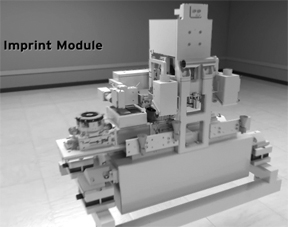Monday, March 1st, 2010
Molecular Imprints, Inc, announced their first nanopatterning tool designed for pilot and volume production of patterned hard disc drive (HDD) substrates at the SPIE Advanced Lithography Symposium in San Jose, CA February 22. The NuTera HD7000 uses Jet and Flash Imprint Lithography (J-FIL) technology to print over 300 double sided disks per hour up to 95mm diameter. The cost of patterned media lithography with the new tool is claimed to be less than $0.50 per disk, excluding the template cost.
With four print heads (see figure), the HD7000 has a footprint 40% smaller than the previous HD2200 tool. The new tool is also equipped for factory automation with interface flexibility to accommodate various cassette formats. Consumables are minimal because the enhanced IntelliJet drop patterning technology dispenses picoliter droplets of resist exactly where needed, with no waste.
Mark Melliar-Smith, CEO of Molecular Imprints revealed that the first two tools had passed Beta test in Austin and one had been shipped to an undisclosed hard disk drive manufacturer. This order brings the total systems sold to the HDD industry by Molecular Imprints to 13, as manufacturers focus on transitioning into the terabit era through their implementation of patterned media.
“Patterned media is essential to HDD manufacturers in realizing sustainable gains in areal density beyond the one terabit threshold,” stated Mark Melliar-Smith. “HDD manufacturers are currently leveraging the high-resolution patterning performance of our J-FIL technology in their patterned media development programs. As the first nanopatterning solution capable of pilot- and volume-production applications, the NuTera HD7000 serves as a critical vehicle to the ultimate goal of achieving patterned media volume production.”
In a separate interview with BetaSights, Melliar-Smith also described the progress in replicating templates using their Perfecta TR1100 tool. Since master masks for hard disk drives take weeks to write using Gaussian beam electron lithography with rotating stages, perfect and damage free replication of those masters is essential to an imprint lithography paradigm. Two TR1100 have been shipped, one to Hoya, a mask maker and one to an HDD manufacturer. These tools are being used to replicate templates on 6” round substrates at speeds of up to 10 per hour. The replicated templates, in turn, are used to pattern the final discs using the J-FIL process.
Low cost patterned media is now seen as essential to progress in HDD density, which has grown faster than Moore’s Law for decades. However, now there are fundamental stability issues for the small magnetic domains on today’s flat disks. The solutions contemplated begin with discrete tracks – essentially lines and spaces printed concentrically around the disk with pitch below 50nm – and progress into bit patterning with ~20nm dots arrayed in tracks. Even now, complex servo patterns along with the tracks, making the challenge more similar to that in the semiconductor industry than one might expect, according to Melliar-Smith. Thus the NuTera HD7000 enjoys some synergy with other Molecular Imprint programs.
IC plans (UPDATE 100308)
With the realities of line edge roughness and Fourier optics impacting the design and yield of both optical and EUV lithography, where can the IC fab industry go for arbitrary patterns printed smoothly? According to Melliar-Smith, it will be his company’s J-FIL system! Overlay has already been reduced below 20nm in mix and match applications with a 193nm immersion stepper. Data taken at SEMATECH indicates that overlay can be improved with frequent template cleaning or overfill-insensitive alignment marks. At 22nm, Mellair-Smith predicted J-FIL will have the lowest CoO – neglecting mask cost.
Mask cost and lifetimes may not be a gating factor. DNP has already produced 14nm line-space J-FIL masks, according to Naoya Hayashi of DNP. Masks with the 22nm patterns needed for NAND flash in 2013 can now be produced using a 50KV e-beam tool. The etch depth uniformity of 1.8nm is good enough already. However, Hayashi worries that there is no inspection tool for imprint templates, forcing vendors to rely on wafer inspection. Even a new Hermes MicroVision inspection tool will take 32 hours to inspect one field. DNP expects to begin production of replica templates by imprinting the master masks in 2012. Template repair has been proven to work at 32nm, Hayashi reports. –M.D.L.

